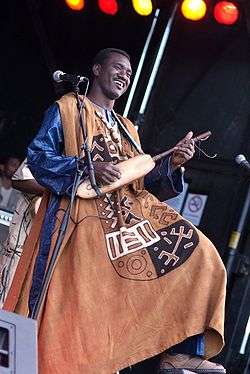Ngoni (instrument)

The ngoni or "n'goni" is a string instrument originating in West Africa. Its body is made of wood or calabash with dried animal (often goat) skin head stretched over it. The ngoni, which can produce fast melodies, appears to be closely related to the akonting and the xalam. This is called a jeli ngoni as it is played by griots at celebrations and special occasions in traditional songs called fasas in Mandingo. Another larger type, believed to have originated among the donso (a hunter and storyteller caste of the Wasulu people) is called the donso ngoni. This is still largely reserved for ceremonial purposes. The donso ngoni, or "hunter's harp" has six strings. It is often accompanies singing along with the karagnan, a serrated metal tube scraped with a metal stick. The smaller kamale ngoni has entered popular musical styles such as Wassoulou music.
The ngoni is known to have existed since 1352, when Ibn Battuta, a Moroccan traveller reported seeing one in the court of Mansa Musa. It is believed to have evolved into the banjo in North America after Mande slaves were exported there. Battuta also reported the balafon.
Kamale ngoni
The kamale ngoni or "young man's harp" was invented by the musician Alata Brulaye in the 1960s. It is smaller than, and tuned a fourth higher than, the traditional ngoni, often made of calabash rather than wood, and has eight, ten or twelve strings. It became popular in the Wassoulou region and contributed to the rise of Wassoulou music in the 1980s and '90s.[1]
Notable players
- Banzumana Sissoko
- Cheick Hamala Diabate
- Issa Bagayogo
- Moriba Koïta
- Bassekou Kouyate
- Andra Kouyaté
- Baba Sissoko
- Mamadou Kouyate, player of the little-known bass ngoni, appeared at The 2013 Proms
- Craig Myers, from The Mike Gordon Band
- Abdoulaye Kone from Sidi_Touré Band
- Sam Dickey
- Ramon Goose
- Mamah Diabaté from Rokia Traoré Band
- Justin Adams
- Adama Dicko
See also
References
- ↑ Eyre, Banning (2003). "The Music of Mali Today" in "Mali Lolo! Stars of Mali" [CD Booklet]. Washington DC: Smithsonian Folkways Recordings.
| Wikimedia Commons has media related to Ngoni (instrument). |